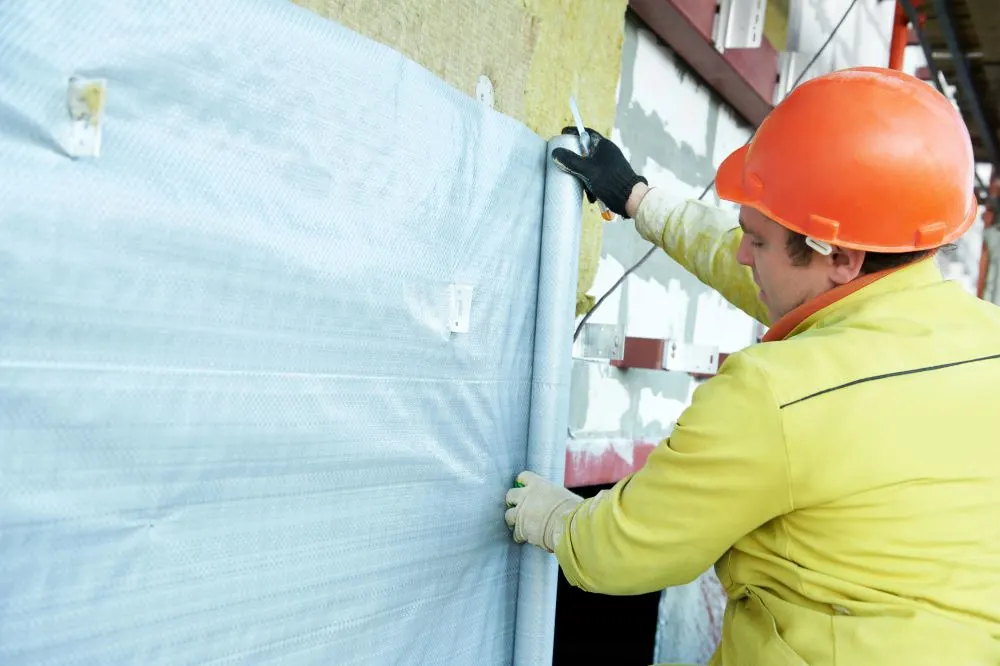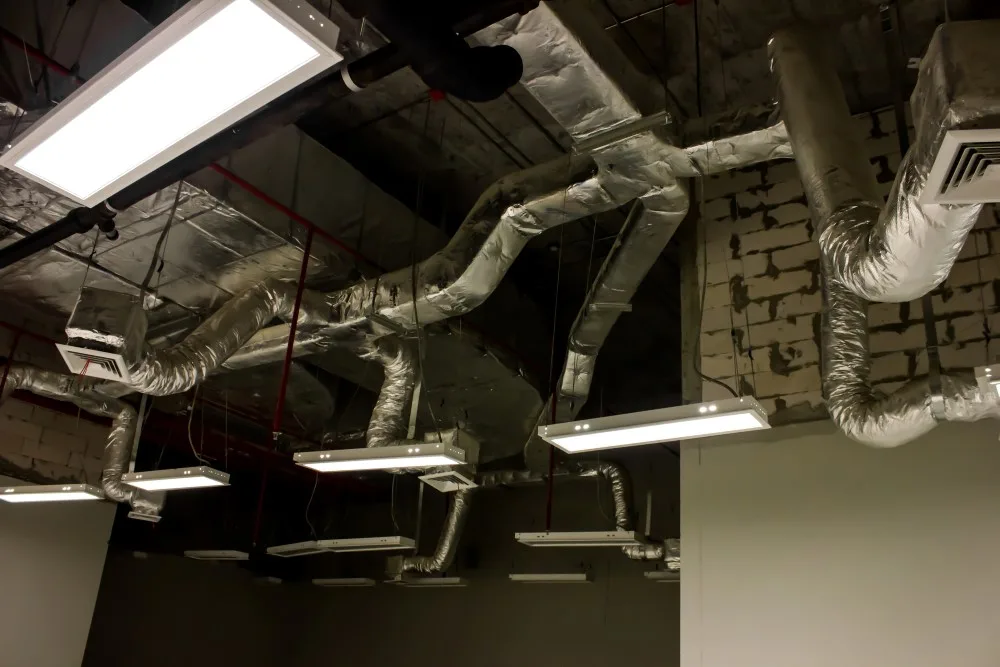Basements are often the coolest places in the house, but on rare occasions, they can be warmer than the floors above them. Solutions for a hot basement are a lot harder to come across than solutions for a cold basement. However, I have spent time researching why some basements are warmer than the rest of the house and coming up with some really helpful ways to fix this problem.

- Exterior insulation
- Unsealed HVAC connections
- Furnace trunk air leaks
- Inefficient glazing in walkout basement
- Heat-generating appliance in basement
- Humidity making basement feel hotter
1. Primary Reason: Exterior Insulation
What Is Exterior Insulation?
Exterior insulation consists of two to six inches of a rigid type of foam. This foam is placed on the outside of the framing of the home and may either be the final outer later or be covered in siding.

Adding exterior insulation is possible for most types of homes, regardless of age. This protective layer makes it possible for homes, especially older ones, to lose significantly less energy.
Exterior insulation would make the most sense for houses that have solid walls, which have no cavity in between them, so insulation cannot be installed there, and you either have to install insulation on the interior of your home or on the exterior.
Interior insulation would mean that you lose floor space, but exterior insulation would mean no floor space is lost and can make the outside of your home look newer and better.
Solid walls are common in older homes, houses outside of the USA, and/or those that are in very cold climates.
How Does Exterior Insulation Work?
Exterior insulation is a good idea in cold climates since it greatly decreases the amount of heat lost by the home.
Heat is drawn outside faster when the temperature difference between the interior of the basement and the outside is larger (e.g., in cold climates). Heat in this case does not necessarily mean that your bathroom is hot, just hotter than outside.
The basement walls become a conduit for thermal energy and the movement of heat through the walls is known as cold bridging.
Bear in mind that in addition to the temperature difference, the inherent thermal conductivity of the materials also determines how fast the heat can be lost. But for the sake of our discussion, we are just going to focus on the temperature gradient.
When the basement walls are in contact with the ground (or air) outside, then the material loses most of its heat. The thermal energy in the air inside the basement naturally and rapidly moves through the material to the outside.
If the walls have exterior insulation, then the basement walls remain at a warmer temperature (they retain whatever heat they have and don’t leach as much from the basement air) and cold bridging is significantly reduced.
Any heat building up in the basement cannot escape.
Seasonal Influence
Exterior insulation contributes to a basement that is warmer than the rest of the house in the way described above but there is a seasonal aspect to it as well, which is heightened by the presence of exterior insulation.
The basement is cooler in the summer and warmer in the winter (as counterintuitive as that sounds).
According to a study conducted in Canada:
“the foundation is often a location of thermal bridging, and the mass of concrete and the soil surrounding it are slow to respond to changes in outdoor conditions.”
Their study also states:
“On the interior of the concrete foundation wall, surface temperature at soil level depends on the average outdoor temperature histories from the past 3 days, while surface temperature near the base of the wall depends on average outdoor temperature histories from the past 69 days.”
69 days is more than two months, so the temperatures you are experiencing in your basement in January could be reminiscent of the temperatures of the soil in November.
The rest of the home would not have the slow rate of temperature change that the basement’s foundation and surrounding soil would have, so it would experience the same heat or cold of the current season.
In the winter, if you have exterior insulation, it is likely that your basement is experiencing the temperatures of the past warmer months while the rest of your home is colder and is experiencing the cold of the current month.
How to Stop the Temperatures Rising Too High
The differences in heat between your basement and the rest of the house shouldn’t be large since the exterior insulation in addition to the foundation slows heat transfer.
If the difference is uncomfortable, though, you can do something about it. There are a few simple fixes that largely have to do with air circulation.
Leaving the basement door open most of the time would allow for excess heat in the basement to rise and spread to the rest of the house. This is also a great way to facilitate ventilation in a basement, especially one without windows.

Having fans in your basement can circulate the air as well, and could potentially help in moving the air from the basement to the rest of the house.
This is typically a technique used to move colder air upstairs and reduce the load on the AC, but it can similarly reduce the load on the heating system during winter if your basement gets hot in the winter months.
If the basement receives the same amount of heating during the winter as the rest of the house, the AC vents can be partially shut to save energy and money as well as to limit the heat of your basement.
However, you should be careful not to alter the air pressure systems in the home as can have several negative side effects for the HVAC system.
2. HVAC Ducts Have Unsealed Connections
Furnaces are often placed in basements so that they are less of an eyesore and so that more space is saved on the main floors of the house.
When temperatures are low enough and the heating must be turned on, the heat is coming from the furnace in the basement.
If your HVAC ducts have unsealed connections, especially if these connections are in the basement, the basement’s temperature is sure to rise and the rest of the house will be colder.
- If connections are unsealed in the basement, hot air is escaping into the basement, raising its temperature.
- Leaking of warm air into the basement when it is meant to be transported to higher floors means that these floors are receiving less warm air in comparison to what they would be receiving if the ducts were sealed.
How to Check if Ducts Have Poorly Connections
Thankfully, duct leaks are easy to spot and test for. A smoke stick, incense, or a thin piece of toilet paper will be useful for finding leaks.
Inspect each duct joint or connection with your chosen material. If the smoke from the smoke stick or incense begins to move in strange ways, or if the thin piece of toilet paper begins to move when put up to the joint/connection it is likely that there is a duct leak.
Materials may not even be needed, since large enough leaks can be felt by your hand (the sensation would be of air blowing onto your skin).
Solution: Seal the Ducts
There are a variety of duct sealing methods, each with its own advantages and disadvantages.

The first would be duct sealing tape. It is also known as aluminum foil tape (amazon link) and is readily available online and at any hardware store. The tape is applied to where the duct leaks are.
Duct sealing tape is easy to find, easy to use, and not as messy as other methods. It is not a perfect method, though. It does not last as long, can be a bit more expensive, and does not perform as well as other methods.
The second method is mastic duct sealant. This method is cheaper, more durable, and performs better than duct sealing tape. You can use any paintbrush to apply the mastic duct sealant to the leak as well as a caulk gun if you would like. The liquid then dries and forms an air-tight seal.
The main disadvantage to using mastic duct sealant is the fact that it can be fairly messy.
The third method is to have a professional seal your leaking ducts for you. This method will be the most expensive but should be the most efficient and best quality.
Additionally, most companies have advanced software for identifying leaks, so they can find the smallest of leaks that you wouldn’t be able to find and they’d find the leak much faster than you could.
3. There Are Air Leaks in the Furnace’s Main Trunk
A furnace trunk is the largest duct leading out of the furnace that carries warm air to the rest of the house. The main trunk often travels throughout the entire home and tapers towards the end for the efficiency of the moving air. Smaller ducts stem from the main trunk to transport air to different rooms.
If there were to be an air leak from the furnace’s main trunk, specifically the largest portion of the trunk in the basement, this would certainly leave the basement hotter than the rest of the home, even in winter.
As with unsealed connections of the vents, leaking of the furnace’s main trunk will lead to excess hot air in the basement and a lack of warm air in the rest of the house.
Leaving leaks in your furnace creates an obvious difference in temperature between your basement and the rest of your home.
It also greatly decreases the energy efficiency of your furnace, leading to you needing to run it more often to get the desired temperature in the rest of your home. Running the furnace more often leads to increased energy consumption and, therefore, higher bills.
How to Seal Leaks in a Furnace
Although furnaces can be quite dangerous because of their heat generation, it is important to use materials that are not flammable or sensitive to heat in any way.
Sealing leaks in a furnace does not have to be done by professionals, although hiring professionals is an option.
For smaller gaps, you can use regular silicone caulk. For smaller gaps near the heat exchanger, it is important to use high-temperature silicone caulk (amazon link), since any other type can melt.
For larger gaps, you can use a foam-type sealant. This type of sealant expands to close larger gaps and can be shaped and painted to match your furnace.
For all types of gaps, it is important to further seal the gap with aluminum foil tape (which is not the same as duct tape).
4. Your Walkout Basement Has Glazing
Unlike double-glazed windows, which have two layers of glass with a layer of gas in between them for maximizing insulation, single-glazed windows are a single pane of glass. Glass is a natural heat conductor, so single glazed windows are known for poor temperature regulation.
The same applies to poorly installed or open glazed windows.
Because of this, in the winter, you lose heat and in the summer, you gain heat.
This absorption of heat and radiating it into your basement can lead to a very warm basement in the summer. On a hot summer day, heat can easily be conducted into your walkout basement, increasing the temperature and making your basement warmer than if it had double glazing.
If you are not sure if your basement windows are single- or double-glazed, then I have detailed 4 different methods (with pictures!) that you can use to check.
Making Your Windows Work for You
There are some simple ways to make a single-glazed window, or any sort of window that allows for too much heat loss/gain, more energy efficient.
One way can be integrated with the decor of your walkout basement. Thermal curtains and insulating blinds discourage heat loss and gain and can add to the basement’s aesthetic appeal while doing so.
Plastic film or shrink-wrap is also a fair technique to combat the natural properties of glass that lead to heat loss or gain.
You can also replace your windows with more insulating ones. It’s relatively costly and invasive, but most would consider it a worthwhile investment.
5. Heat-Generating Appliances in Basement
Basements tend to be great places to store large, noisy, and/or heat-generating appliances. Appliances that generate heat include furnaces, air conditioners, dryers and hot water heaters. Even appliances like a water softener and a sump pump can generate heat in your basement.
With all of these appliances being in the same area and generating heat, even small amounts of heat can add up and accumulate, leading to a higher temperature in your basement compared to the rest of your house since it is not subjected to the same amount of heat from these appliances.
Heat coming from appliances is a normal phenomenon, especially when the appliances themselves are used to generate heat. Nonetheless, this heat can accumulate and cause noticeably high temperatures in your basement.
Counteracting the Appliance Heat
The creation of heat from appliances in the basement is largely unavoidable since as long as these appliances are functional, there will be excess heat.
It is possible, however, to redistribute said heat to make basement temperatures more comfortable.
The key to redistributing this heat is ventilation. Ventilation of your basement can be done with normal standing fans, exhaust fans, or similar kinds of ventilation that are capable of redistributing the air in your basement.
Leaving the door open to your basement can allow the hot air to rise to the rest of the house, which can cool the basement as well as heat the rest of the home.
Although heat from basement appliances is fairly normal, it is possible that excess heat may be occurring from malfunctioning machinery or overheating of appliances.
If you feel that your basement’s temperature is high due to malfunctioning machinery, it would be best to investigate and conduct any repairs necessary.
You can even go the more extreme route of moving some of your appliances out of the basement. Now, you can’t move your furnace! But you can move your washer and dryer.
6. Humidity Makes the Basement Feel Hotter
Basements are unfortunately known for being the most humid and moist area of the house for a variety of reasons.
Soil contains a varying amount of water and since most basements are completely surrounded by it, water from soil is bound to make its way into the basement.
Water can move into the basement through vapor diffusion, where moisture from soil moves up and through porous foundation walls and floors and into the basement.
Water can also move through various cracks that tend to form in the basement foundation.
Capillary suction is another way water migrates into the basement. Water from moist soils is moved into the basement through the small pores in the concrete and walls.
With all of these factors and more (which you can find in Reasons Why Basements Are Humid (With solutions)), it’s no wonder basements are so humid, and with humidity comes the sensation of rising temperatures.
This is because high humidity interferes with the body’s natural process of cooling itself down: sweating.
Sweating works by taking heat away from the body through the evaporation of sweat droplets. When the air in the basement has high humidity, though, the sweat evaporation process is not as efficient, and therefore, your body temperature is not as easily regulated.
In a humid basement, when your body attempts to regulate its temperature through sweating, this process is slowed down by the high humidity and the air feels hotter than it actually is.
Reducing Basement Humidity
Thankfully, reducing basement humidity can be done somewhat easily and through various processes.
A dehumidifier is a very direct way to rid your basement of unwanted moisture. The market for dehumidifiers is vast, so there is a great range of prices, efficiencies, and sizes that you can choose from.
Since basements are so easily flooded, a drainage system is a very good idea. This is not only because floods can damage anything stored in your basement as well as furniture, walls, etc., but also because standing water in your basement raises humidity levels.
Water can enter your basement through cracks in your foundation, so it is wise to seal these cracks. Not only will this improve the look of your basement, but it will also deter humidity.
If you have a walkout basement with windows, keeping your windows shut if you live in a humid area is a simple fix to limit humidity in your basement. Even though opening windows is thought to negate humidity, opening them to hot, humid air will only make the problem worse.
Ventilating a basement can help to control the temperature.
Sources
https://www.greenbuildingadvisor.com/article/exterior-insulation-is-like-a-sweater-for-your-house
https://www.eco-home-essentials.co.uk/exterior-wall-insulation.html
https://nrc-publications.canada.ca/eng/view/ft/?id=400b4217-7269-40df-b0dc-60a86ec2c8e3
https://aeroseal.com/air-duct-sealing-blog/duct-sealing-methods/
https://www.familyhandyman.com/article/diy-dictionary-trunk-line/




